Books in the Mail
Last month Pyr sent us a hand full of books including the first three books in their new Young Adult line: Lightbringer by K. D. McEntire, Planesrunner by Ian McDonald and Thief’s Covenant by Ari Marmell. Pyr expects YA books to make up a full third of their annual lineup so we can expect to see many more YA books to follow.
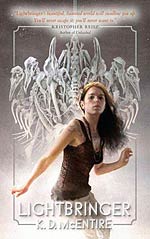 Lightbringer
Lightbringer
K. D. McEntire
Wendy has the ability to see souls that have not moved on-but she does not seek them out. They seek her. They yearn for her . . . or what she can do for them. Without Wendy’s powers, the Lost, the souls that have died unnaturally young, are doomed to wander in the never forever, and Wendy knows she is the only one who can set them free by sending them into the light.
Each soul costs Wendy, delivering too many souls would be deadly, and yet she is driven to patrol, dropping everyone in her life but her best friend, Eddie-who wants to be more than friends-until she meets Piotr.
Piotr, the first Rider and guardian of the Lost, whose memory of his decades in the never, a world that the living never see, has faded away. With his old-fashioned charms, and haunted kindness, he understands Wendy in ways no one living ever could, yet Wendy is hiding that she can do more than exist in the never. Wendy is falling for a boy who she may have to send into the light.
But there are darker forces looking for the Lost. Trying to regain the youth and power that the Lost possess, the dark ones feed on the Lost and only Wendy and Piotr can save them-but at what cost?
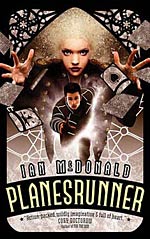 Planesrunner
Planesrunner
Ian McDonald
There is not one you. There are many yous. There is not one world. There are many worlds. Ours is one of billions of parallel earths.
When Everett Singh’s scientist father is kidnapped from the streets of London, he leaves young Everett a mysterious app on his computer. Suddenly, this teenager has become the owner of the most valuable object in the multiverse-the Infundibulum-the map of all the parallel earths, and there are dark forces in the Ten Known Worlds who will stop at nothing to get it. They’ve got power, authority, and the might of ten planets-some of them more technologically advanced than our Earth-at their fingertips. He’s got wits, intelligence, and a knack for Indian cooking.
To keep the Infundibulum safe, Everett must trick his way through the Heisenberg Gate his dad helped build and go on the run in a parallel Earth. But to rescue his Dad from Charlotte Villiers and the sinister Order, this Planesrunner’s going to need friends. Friends like Captain Anastasia Sixsmyth, her adopted daughter Sen, and the crew of the airship Everness.
Can they rescue Everett’s father and get the Infundibulum to safety? The game is afoot!
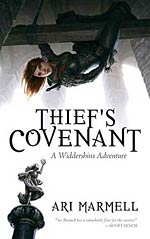 Thief’s Covenant
Thief’s Covenant
Ari Marmell
Once she was Adrienne Satti. An orphan of Davillon, she had somehow escaped destitution and climbed to the ranks of the city’s aristocracy in a rags-to-riches story straight from an ancient fairy tale. Until one horrid night, when a conspiracy of forces-human and other-stole it all away in a flurry of blood and murder.
Today she is Widdershins, a thief making her way through Davillon’s underbelly with a sharp blade, a sharper wit, and the mystical aid of Olgun, a foreign god with no other worshippers but Widdershins herself. It’s not a great life, certainly nothing compared to the one she once had, but it’s hers.
But now, in the midst of Davillon’s political turmoil, an array of hands are once again rising up against her, prepared to tear down all that she’s built. The City Guard wants her in prison. Members of her own Guild want her dead. And something horrid, something dark, something ancient is reaching out for her, a past that refuses to let her go. Widdershins and Olgun are going to find answers, and justice, for what happened to her-but only if those who almost destroyed her in those years gone by don’t finish the job first.
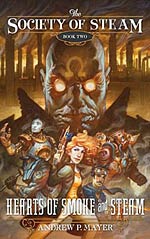 Hearts of Smoke and Steam
Hearts of Smoke and Steam
The Society of Steam: Book 2
Andrew P. Mayer
Sir Dennis Darby has been murdered, the Automaton has been destroyed, and Sarah Stanton has turned her back on a life of privilege and comfort to try and find her way in the unforgiving streets of New York. But Lord Eschaton, the villain behind all these events, isn’t finished with her yet. His plans to bring his apocalyptic vision of the future to the world are moving forward, but to complete his scheme he needs the clockwork heart that Sarah still holds.
But she has her own plans for the Automaton’s clockwork heart-Sarah is trying rebuild her mechanical friend, and when she is attacked by The Children of Eschaton, the man comes to her rescue may be the one to make her dreams come true. Emelio Armando is a genius inventor who had hoped to leave his troubles behind when he and his sister left Italy for a life of anonymity in the New World. Now he finds himself falling in love with the fallen society girl, but he is rapidly discovering just how powerful the forces of villainy aligned against her are, and that fulfilling her desires means opening the door to a world of danger that could destroy everything he has built.
THE SOCIETY OF STEAM takes place in a Victorian New York powered by the discovery of Fortified Steam, a substance that allows ordinary men to wield extraordinary abilities, and grant powers that can corrupt gentlemen of great moral strength. The secret behind this amazing substance is something that wicked brutes will gladly kill for, and one that Sarah must try and protect, no matter what the cost.
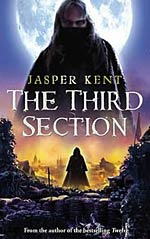 The Third Section
The Third Section
The Danilov Quintet: Book 3
Jasper Kent
The third novel in Jasper Kent’s enthralling, chilling and acclaimed historical vampire sequence — The Danilov Quintet.
Russia 1855. After forty years of peace in Europe, war rages. In the Crimea, the city of Sevastopol is besieged. In the north, Saint Petersburg is blockaded. But in Moscow there is one who needs only to sit and wait — wait for the death of an aging tsar, and for the curse upon his blood to be passed to a new generation.
As their country grows weaker, a brother and sister — each unaware of the other’s existence — must come to terms with the legacy left them by their father. In Moscow, Tamara Valentinovna Lavrova uncovers a brutal murder and discovers that it is not the first in a sequence of similar crimes, merely the latest, carried out by a killer who has stalked the city since 1812.
And in Sevastopol, Dmitry Alekseevich Danilov faces not only the guns of the combined armies of Britain and France, but must also make a stand against creatures that his father had thought buried beneath the earth, thirty years before.
Automata 101: Cyborgs and Androids – Part 2
Rhonda Knight is an Associate Professor of English at Coker College in Hartsville, SC. She teaches Medieval and Renaissance literature as well as composition courses. This blog will outline her experiences teaching an Honors English Composition course about created entities, beginning with the golem of Jewish legend and continuing through cyborgs, robots, androids, and artificial intelligence.
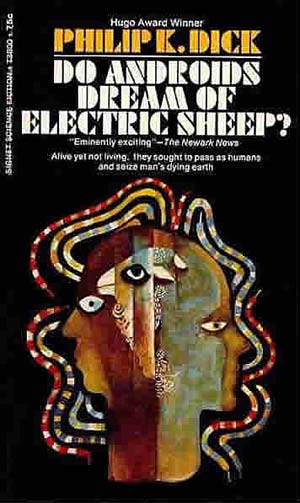 I taught Philip K Dick’s Do Androids Dream of Electric Sheep? and Ridley Scott’s Blade Runner (1982) as a unit. I had not taught a PKD novel before, and I thought that his style would be a challenge for the students. Previously, I had taught some of his short stories (“The Hanging Stranger,” “Exhibit Piece,” “The Chromium Fence,” “We Can Remember It For You Wholesale,” “The Minority Report,” and “Paycheck”) in a science fiction class to mixed results. In that class, the students who were familiar with such shows as The Twilight Zone and The Outer Limits were able to see similarities between them and PKD’s stories. However, most of them did not have the historical understanding of 1950s and 1960s suburbia to grasp his deep satire of that life.
I taught Philip K Dick’s Do Androids Dream of Electric Sheep? and Ridley Scott’s Blade Runner (1982) as a unit. I had not taught a PKD novel before, and I thought that his style would be a challenge for the students. Previously, I had taught some of his short stories (“The Hanging Stranger,” “Exhibit Piece,” “The Chromium Fence,” “We Can Remember It For You Wholesale,” “The Minority Report,” and “Paycheck”) in a science fiction class to mixed results. In that class, the students who were familiar with such shows as The Twilight Zone and The Outer Limits were able to see similarities between them and PKD’s stories. However, most of them did not have the historical understanding of 1950s and 1960s suburbia to grasp his deep satire of that life.
Of course, much of Do Androids deals with the satire of that “Keeping Up with the Joneses” attitude we often connect with the suburban lifestyle. With a little bit of prompting, the students in my current class began to see the materialism of the society in Do Androids and were able to connect it to our culture. We talked about how in the cultural capital of Deckard’s world the status of owning a horse could equate to our status in owning smart phones, designer clothing and expensive cars. We talked about how the title Do Androids Dream of Electric Sheep? has multiple meanings that feed into that American Dream/”Keeping Up with the Joneses” attitude for both the humans and the androids in the text. The humans, represented by Deckard, are dreaming not of electric sheep but real ones. For the androids, owning an electric sheep would be a sign that they were successfully passing as humans. Therefore, they would not care if the sheep were electric or organic. The androids want the lives of the humans, but can they really achieve that type of lifestyle? Would the domestic lives of androids only be simulacra of humanity, minus feeling and empathy?
Given our discussion of the posthuman in He, She and It, much of our discussion centered on the ways that the humans exhibited posthuman qualities through the use of the Penfield mood organs and through the Mercer empathy boxes. 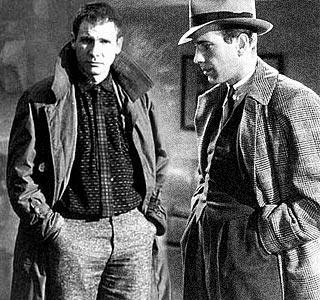 This was not where I planned for the conversation to go that day, so I was especially proud that the students were making connections between the readings and bringing them up. I will confess that none of us really understood Mercerism, but we feel that we all have a greater understanding of empathy. In preparation for teaching this book, I found a very interesting podcast by David Gill that helped me formulate some of my ideas. Later, I found an interview with Gill that was also helpful. One of Gill’s interesting insights in this interview is that “Scott wanted to talk about how great Androids could be. Dick wanted to talk about how crummy humans could be.”
This was not where I planned for the conversation to go that day, so I was especially proud that the students were making connections between the readings and bringing them up. I will confess that none of us really understood Mercerism, but we feel that we all have a greater understanding of empathy. In preparation for teaching this book, I found a very interesting podcast by David Gill that helped me formulate some of my ideas. Later, I found an interview with Gill that was also helpful. One of Gill’s interesting insights in this interview is that “Scott wanted to talk about how great Androids could be. Dick wanted to talk about how crummy humans could be.”
I planned the syllabus so that the students could watch Blade Runner while I was away at the Blackfriars Conference. Because of this, I started out training them to watch PKD as interpreted by Ridley Scott. Once I started teaching I realized that I could have spent a month just doing this. However, in my shorthand version, I tried to introduce the students quickly to hard-boiled detectives and film noir. I explained to them how Blade Runner interprets Do Androids through these two genres. In my opinion, Scott’s Deckard is the descendant of Philip Marlowe and Sam Spade—PKD’s Deckard, not so much. I showed the students the openings (15-30 minutes) of three movies, Laura (1944), Double Indemnity (1944), and L.A. Confidential (1997). I wanted them to see the noir visual characteristics of light and shadow as well as hear the typical hard-boiled, tough guy patter. If I had more time, I would have added The Big Sleep (1946) to really encapsulate the characteristics of the detective. I was able to show the students the first section of Blade Runner before I left for the conference. We were able to compare Scott’s use of smoke, light and shadow with the scenes that we watched in the other movies.
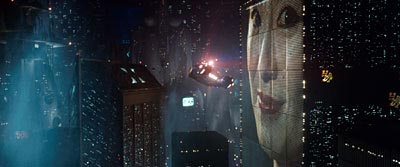 The students finished most of the movie while I was away, and then we watched the ending when I returned. We discussed the ambiguous ending and the different characterizations of Deckard, Rachael, Pris and Roy. The students were very interested in the setting and were somewhat confused by the prevalence of Asian culture. I explained to them that Dick was a northern Californian and that Do Androids is set in San Francisco (they had missed the clues). At that point, someone made the connection to Chinatown, and they decided they liked Scott’s choice once they understood the reasons for it.
The students finished most of the movie while I was away, and then we watched the ending when I returned. We discussed the ambiguous ending and the different characterizations of Deckard, Rachael, Pris and Roy. The students were very interested in the setting and were somewhat confused by the prevalence of Asian culture. I explained to them that Dick was a northern Californian and that Do Androids is set in San Francisco (they had missed the clues). At that point, someone made the connection to Chinatown, and they decided they liked Scott’s choice once they understood the reasons for it.
I learned long ago that when teachers teach texts that they love too much they are bound to get their feelings hurt when the students don’t react the way they wish. I tried to protect myself with Blade Runner and observed some interesting things. First, in the students’ minds Blade Runner, Double Indemnity, and Metropolis are all “old movies.” They always react to the alterity of the movies first before they react to the narratives. They have a hard time either ignoring or embracing the strangeness of the form. Second, they were able to watch the movie without all of the 80s popular culture baggage that I experienced then and still experience now. For example, they have no sense of Darryl Hannah or Rutger Hauer outside that film, while these actors’ later success has always influenced my subsequent viewings of the movie. At one point I mentioned that the movie was released on the tail of Harrison Ford’s success as Han Solo and Indiana Jones. A student said “Oh, that’s who he is. I thought he looked familiar.” All I could do was shrug. In a way, this lack of knowledge gave them a purer viewing experience than I could ever have. Third, the students preferred the movie to the book but were not always able to articulate why. With prodding, they figured out that the sex between Rachael and Deckard was off-putting in the book but not in the movie because in the movie there was a hope that the catalyst was romance not ego or manipulation. 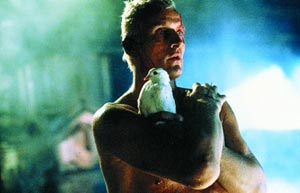 They also liked Deckard better in the movie because he seems stronger. I explained to them that their expectations had been programmed by the hard-boiled detective even though they have never seen a Humphrey Bogart movie and don’t know who he is (really, they don’t). They missed the gadgets in the movie but not Mercerism. They were also surprised that mankind’s relationship with animals was such a footnote in the movie since it was so important in the book.
They also liked Deckard better in the movie because he seems stronger. I explained to them that their expectations had been programmed by the hard-boiled detective even though they have never seen a Humphrey Bogart movie and don’t know who he is (really, they don’t). They missed the gadgets in the movie but not Mercerism. They were also surprised that mankind’s relationship with animals was such a footnote in the movie since it was so important in the book.
All in all, this was a successful section, but it has made me think about PKD even more. I’ve not read many of his novels, only The Man in the High Castle besides Do Androids, but I have been following Charles Dee Mitchell’s blog on this site, and it is helping me decide which books I might want to read (and the ones that I don’t).
Philip K. Dickathon: The Three Stigmata of Palmer Eldritch
Guest Blogger and WWEnd Member, Charles Dee Mitchell, has contributed a great many book reviews to WWEnd and we’ve invited him to contribute to our blog. This is the latest in Dee’s series of Philip K. Dick reviews that he started on his blog www.potatoweather.blogspot.com. We’ll be posting one every week until he runs out of reviews or gets tired of Philip K. Dick books.
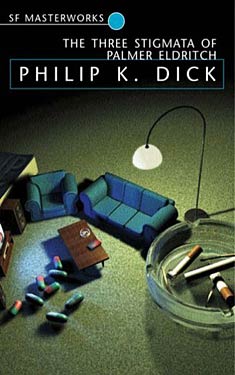 This is how bad things have gotten. Earth is over-heated and over-crowded. If you go outside during the day you must wear a portable cooling pack and stay under anti-thermal protective shades until you can grab a passing jet taxi or "thermosealed, interbuilding commute car." The U.N. has a forced emigration policy designed to provide colonists to Mars and a few other locations. But everyone knows that life off Earth will be even more miserable than what they face here. The colonists serve no real purpose since agriculture is difficult with frozen methane storms and pesky alien creatures that may eat either your struggling crops or yourself. When draft notices arrive, anyone who can afford one hires a psychiatrist in a box. Its purpose is to keep your mind so addled you will never pass the psych examination when the U.N. tries to ship you off to the boonies.
This is how bad things have gotten. Earth is over-heated and over-crowded. If you go outside during the day you must wear a portable cooling pack and stay under anti-thermal protective shades until you can grab a passing jet taxi or "thermosealed, interbuilding commute car." The U.N. has a forced emigration policy designed to provide colonists to Mars and a few other locations. But everyone knows that life off Earth will be even more miserable than what they face here. The colonists serve no real purpose since agriculture is difficult with frozen methane storms and pesky alien creatures that may eat either your struggling crops or yourself. When draft notices arrive, anyone who can afford one hires a psychiatrist in a box. Its purpose is to keep your mind so addled you will never pass the psych examination when the U.N. tries to ship you off to the boonies.
Barney Mayerson’s shrink is Dr. Smile, and he is supposed to be one of the best. But Barney should be able to beat his draft notice in any case. He is the New York Pre-Fash consultant for Perky Pat Enterprises. This means he uses his precognitive abilities to judge whether products presented as possible new additions to Perky Pat’s layout will be a success. PP is a doll with a dreamy life and dreamy boyfriend –let’s face it, they’re Barbie and Ken. Colonists in their Martian hovels spend hours playing with Perky Pat, aided by the illegal drug, Can-D. (The drug is manufactured on Venus by Perky Pat Enterprises.) A chaw of Can-D gives participants up to an hour or so of complete identification with PP and her world.
Life for Barney, his new girlfriend/assistant Betty, and their boss Leo Bolero is good until word comes that renegade industrialist Palmer Eldritch has crash landed on Pluto after a decade spent outside the solar system. Rumor has it that that he has brought back with him a new drug, Chew-Z. (PKD was never one to shy away from puns.) Chew-Z is better than Can-D. It requires no layouts but instead puts the user into a completely realized fantasy world. And Eldritch has won U.N approval, so it is legal. Perky Pat Enterprises will be destroyed.
This might be a good time to mention that The Three Stigmata of Palmer Eldritch is PKD‘s first overtly religious novel. It is one of seven novels written during the amphetamine-fueled years of 1963/64. There is some question as to when PKD first took LSD, but it is difficult not to imagine Can-D and Chew-Z as versions of marijuana and acid. Can-D is a party drug. Chew-Z promises to reveal new levels of reality. It is part of a spiritual quest, but it could also be a trap. There comes a Voltairian moment when Barney decides to chuck everything and just tend his own scraggly Martian garden. That doesn’t last for long. Barney’s quest will bring him into contact with the world of Chew-Z, Palmer Eldritch himself, and whatever exists beyond Palmer Eldritch.
This is the book that 30 years ago sold me on Philip K. Dick. I had seen Blade Runner and read, since it was supposed to be PKD’s best novel, The Man in the High Castle. I liked it OK, but then I happened to pick up Palmer Eldritch. The screwball pacing, deadpan humor, and imaginative monsters were the perfect cover for the serious thought that lurked in the background. Even though I was hooked — an appropriate term when discussing PKD — I read him only sporadically until this past year. Now reading all his SF in more or less chronological order is at times a pleasure, a chore, and even saddening. It’s my own Chew-Z trip. And I am just now getting to the good stuff.



















 Full Details
Full Details

